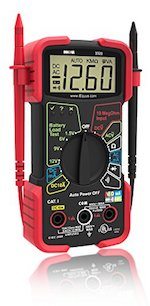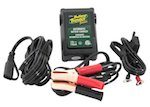Video-Is your Harley-Davidson or other brand motorcycle seem to be cranking over slowly when starting? Does your battery seem to be going bad? Not sure whether you should replace your motorcycle battery?
DIY Instructions Here:
We show you how to easily test your motorcycle battery & charging system using a simple inexpensive digital multimeter right in your very own shop or garage. No need to go running to a dealership to spend money. Be in the know on whether you actually need a new motorcycle battery or not. Or you may find it's not the battery at all and a charging system problem instead.
Your battery may even be holding a charge, but it's the cold cranking amps that may determine if your battery needs replacement.
In this video, we show you how to choose the correct settings on your multimeter & complete all the necessary tests.
Set the multimeter/voltmeter to DC volts (20v range). The particular multimeter listed on this page (left) has an actual 12v setting, making it very easy. Many volt meters might only have a 20v setting, which is the one you should choose and will work the same.
Note: These multimeter settings will be used for all the below motorcycle battery and charging system tests.
A must listen to Law Abiding Biker™ Podcast Episode and Article: Episode #134 (click link below)
Static Battery Voltage Test:
Make certain you have not recently charged your motorcycle battery. Let it sit for at least an hour after disconnecting it from a charger. Turn on your ignition so your headlights are on and other accessories for about two minutes and then turn the ignition off. This is to get rid of any surface charge.
Place the voltmeter leads to the battery terminals. (positive to positive and negative to negative). A good battery should read between 12.4 to 12.6 volts, 12.6v being optimal. If it reads below those values then your battery is not keeping a full charge.
Check out the Official Law Abiding Biker Store!
Starting Battery Load Test: (cold cranking test)
Next, you'll need to determine the cold cranking power that your battery is capable of.
Place the voltmeter leads to the battery terminals. (positive to positive and negative to negative).
Now, start your motor. Good readings will be above 10v, 9.6v being the absolute lowest you'd want to see. If it drops below the 9.6v, the battery has a very low capacity and should be replaced.
 CHECK OUT OUR AWESOME BIKER TUTORIAL VIDEOS
CHECK OUT OUR AWESOME BIKER TUTORIAL VIDEOS
Charging System Test:
Next, you'll want to determine if your charging system is working and properly feeding your battery when the motorcycle is running.
Place the voltmeter leads to the battery terminals. (positive to positive and negative to negative).
Start your motor and bring the RPM's up to approximately 3,000. You'll want to see a reading of 13.8 to 14.5 volts to know that your stator and regulator/rectifier are operating properly and charging your battery. If not, then you likely have a motorcycle charging system problem.
Best Practice & Battery Maintenance:
Consider keeping your motorcycle battery on a simple inexpensive battery tender that just plugs into a wall outlet. The tenders come with a pig tail that you can hook permanently to your battery. It just has a positive and negative lead to hook to the battery. Most new Harley's all come with the pigtail already installed. Just plug it in and it maintains your battery.
It's an inexpensive way to assure you get the most life out of your motorcycle battery. Even during the summer warm months you can use it, such as a time you may not be riding for a week or so. The worst thing you can do is just let your motorcycle battery sit without being on a tender for longer periods of time. Who wants to prematurely buy a new expensive motorcycle battery?
If you appreciate this free DIY video and information, please consider purchasing any motorcycle batteries or other items through any of our below affiliate links:
Revzilla | J&P cycles | Amazon | Dennis Kirk
If you appreciate the content we put out and want to make sure it keeps on coming your way then become a Patron too! There are benefits and there is no risk.
OR support us via a flat donation:
Join the Free Email Club!
If you appreciate this free information make sure to join the thousands of law abiding bikers that have already joined the free Email Club! You will be notified of new useful motorcycle content and techniques as we put them out. Join the Community now!






Leave a Reply